|
|
|||
|
(Back to Preceding Week; on to Next Week) |
|
SPRING BIRDS,
Hilton Pond Center, smack dab in the middle of the Carolina Piedmont, doesn't sit in a major flyway, so we never get big numbers of Neotropical migrant birds that occur along the coast or mountain ridges in spring and fall. Nonetheless, we see a nice assortment of migratory species, some of which stop temporarily after hitting our mists nets. Late April is an interesting time because winter birds are lingering prior to a trip back north, the Neotropicals are coming through, and our year-round residents are jockeying for mates and territories. During the last ten days in April we banded 15 species--far fewer than what might be caught at a migratory hotbed--but just enough for us to have time to study every individual and, in some cases, take a few photos by which to remember it. We hope you enjoy the following gallery of some of our new finely feathered friends--migrant and otherwise--each of which has a numbered band that eventually may tell us interesting things about migration, longevity, and site fidelity.
All text & photos © Hilton Pond Center We always know when spring migration has begun because we start getting phone calls from folks who breathlessly report a sparrow-sized blue bird at the feeders that's "NOT a bluebird." It's then we know for sure Indigo Buntings have arrived in the Carolina Piedmont. To our eyes, the adult male (above) is one of the most attractive birds in North America, with feathers in shades of blue that go far beyond indigo and nearly defy description. We've also seen these Neotropical migrants on our hummingbird study site in Guanacaste Province, Costa Rica, where most males sport non-breeding plumage--a calico mix of brown and blue.
The female Indigo Bunting (above) looks very different from her mate; we call her "the most nondescript bird in North America." The successful female bunting spends long stretches of time incubating eggs or brooding chicks; her mousy brown color provides camouflage that makes her less obvious to predators when she's on the nest. As female Indigo Buntings age, annual molts typically bring small amounts of color, especially along the vanes of the tail feathers. The female above had a blue cast to her forehead.
We sometimes describe Blue Grosbeaks (adult male, above) as "Indigo Buntings on steroids." They're definitely blue but almost twice the mass of their smaller relatives, and the rusty wingbars of the grosbeak leave little doubt of its identity. (Female grosbeaks, which superfricially resemble that nondescript female Indigo Bunting, are more brown than gray and have the same rusty wingbars as the male.) At Hilton Pond Center, Blue Grosbeaks are much less common than Indigo Buntings--the bird above was only our 62nd banded in 27 years, compared to 341 buntings--so we're always pleased to have one in-hand. We like Blue Grosbeaks for their appearance, but also because we've captured them on our study site in Costa Rica AND because we found a grosbeak nest near York in 1975 with the egg of a Brown-headed Cowbird. We reported this as the first confirmed nest parasitization for York County SC.
It was a good week for banding blue-hued birds at Hilton Pond Center, what with the previously mentioned Indigo Buntings and Blue Grosbeaks AND two female Eastern Bluebirds (above). Female bluebirds aren't nearly as colorful as their mates, whose dorsal feathers are all bright blue, but the wings and tail of the female--plus an orange breast--leave no doubt about her species. It was interesting that one of the female bluebirds had a prominent incubation patch, while the other was not in breeding condition. Since Eastern Bluebirds sometimes employ "helpers at the nest"--related individuals that share chores--it may be the non-breeding bird was one of the other bird's earlier offspring, biding her time. By the way, Carolinas birders often tally big flocks of Eastern Bluebirds on Christmas Bird Counts in December, disproving the myth the species bails out locally during cold weather. In fact, bluebird populations in the Carolina Piedmont may actually INCREASE in winter because local breeders stay on with their fledglings AND we get an influx of migrants from further north.
Although they're present year-round at Hilton Pond Center, we typically see Black-and-white Warblers during spring migration and the breeding season. The adult male (above) fits his name perfectly, with white and black the only colors in its plumage, bill, legs, and eyes. (In the photo above, a pinkish cast on the bird's lower mandible is a reflection from the bander's hand.) Females and juveniles look very much like males but have a much grayer cheek patch. We also knew the bird above was a male because he had a well-developed cloacal protuberance--an indication he's probably a local breeder. A second male Black-and-white Warbler we netted this week did not have the protuberance and was carrying a little body fat, so we suspect he was a migrant just moving through.
Because they're brown and have spotted breasts, a beginning birder sometimes confuses Brown Thrashers with thrushes, but if you've ever been eyeball to eyeball with the former the differences become obvious. An adult Brown Thrasher (above) has a long tail and brilliant yellow eyes--irises in juveniles are a muddy brown-gray--and a long, stout, slightly decurved bill it doesn't hesitate to use on an unwary bander. We've also learned thrashers are quite vocal in the hand and almost always defecate in our direction--which is why we always aim them away from data sheets and the computer during the banding process.
The Chipping Sparrow (above) is another species present all year but whose numbers increase dramatically at feeders in late winter. This small sparrow is at its finest when it acquires its breeding plumage in April, when its brownish cap changes to bright rust and its dingy white facial feathers are replaced by clean white ones. Sexes look alike in this species, but the breeding male gets a remarkably large cloacal protuberance as his hormones rise in the spring. This species nests every year at Hilton Pond Center--usually a few feet off the ground in Eastern Red Cedar trees where the small, tidy nest is typically lined with a soft bed of horsehair.
Unlike our year-round Chipping Sparrows, the White-throated Sparrow occurs at Hilton Pond Center only during "winter," showing up in early October and usually departing by late April. (Our spring banding date of 27 May 2003 was remarkably late, but the species actually has been seen rarely in South Carolina even in mid-summer.) Many observers think dingy-colored White-throated Sparrows (above right) are either females or juveniles that haven't yet acquired breeding plumage, but this isn't correct. Juveniles ARE paler, but there are actually two different color morphs among adult White-throated Sparrows--bright vs. tan. Note that both morphs still have unmarked throats and yellow lores characteristic of the species. Curiously, on their northern breeding grounds females appear to prefer less colorful males as prospective partners--possibly because brighter males try to mate with several females and have less time to pay attention to paternal duties.
During winter, male and female American Goldfinches look pretty much alike, with drab olive-green plumage, dark wings, and brownish bills. When spring arrives, both sexes go through a serious transformation, bringing in yellow body feathers that are much brighter; males (above right) get a jet black forehead. In both sexes, a vernal increase in testosterone causes carotene pigments to be laid down in the bill--beginning at the base and moving distally--and the mandibles acquire a pumpkin-orange color (above). In autumn, testosterone production decreases, carotene deposits cease, and melanin pigment causes the bill to again turn brown. Young of the year, having no significant testosterone, show drab plumage and brown bills until their first spring.
Who can forget that old grade school joke about "What's black and white and red/read all over?" Depending of how one spells red/read, answers can vary from "an embarrassed zebra" to "the daily newspaper," but after this week we'll go with "an adult male Rose-breasted Grosbeak." This big-billed bird is always a delight when it shows up in spring at the feeder, where it can consume sizeable amounts of sunflower seed. Unfortunately, the nattily plumaged grosbeak doesn't very long stay at Hilton Pond Center, continuing instead to breed in the North Carolina mountains and points northward.
Less obvious than the male Rose-breasted Grosbeak is the female (above), who's brown and white and NOT red all over and looks like some sort of giant sparrow. (Actually, females do have a little orange on them but it's under the wing, below right, and seldom seen except by bird banders. Again, Hilton Pond Center doesn't get huge numbers of spring migrant birds, but we enjoy those that do pass through or stay year-round. Our enjoyment is enhanced by the privilege of capturing and banding a few of these AVIAN visitors to our yard--migrant or otherwise--and sharing our photographs with HUMAN visitors to our Web site. Let us know if you like them, and Happy Spring!
All text & photos © Hilton Pond Center
Comments or questions about this week's installment?
Thanks to the following fine folks for recent gifts in support of Hilton Pond Center for Piedmont Natural History and/or Operation RubyThroat: The Hummingbird Project. Your tax-deductible contributions allow us to continue writing, photographing, and sharing "This Week at Hilton Pond." (Please see Support if you'd like to make a gift of your own.)
"This Week at Hilton Pond" is written & photographed You may wish to consult our Index of all nature topics covered since February 2000. You can also use our on-line Hilton Pond Search Engine at the bottom of this page. For a free, non-fattening, on-line subscription to |
|
Make direct donations on-line via
Network for Good: |
|
|
Use your PayPal account
to make direct donations: |
|
|
If you like to shop on-line, you please become a member of iGive, through which more than 700 on-line stores from Barnes & Noble to Lands' End will donate a percentage of your purchase price in support of Hilton Pond Center and Operation RubyThroat. For every new member who signs up and makes an on-line purchase iGive will donate an ADDITIONAL $5 to the Center. Please sign up by going to the iGive Web site; more than 150 members have signed up to help. It's a painless, important way for YOU to support our work in conservation, education, and research. |
|
| The highly coveted Operation RubyThroat T-shirt (four-color silk-screened) is made of top-quality 100% white cotton. It highlights the Operation RubyThroat logo on the front and the project's Web address (www.rubythroat.org) across the back.
Now you can wear this unique shirt AND help support Operation RubyThroat: The Hummingbird Project and Hilton Pond Center. Be sure to let us know your mailing address and adult shirt size: Small (suitable for children), Medium, Large, X-Large, or XX-Large. These quality shirts don't shrink! Price ($21.50) includes U.S. shipping. A major gift of $1,000 gets you two Special Edition T-shirts with "Major Donor" on the sleeve. |
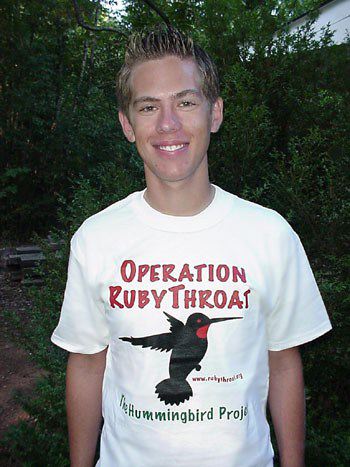
Need a Special Gift for a Want to make a If so, why not use our new handy-dandy on-line Google Checkout below to place your secure credit card order or become a Major Donor today? |
|
|
|
|
SPECIES BANDED THIS WEEK: * = New species for 2008 WEEKLY BANDING TOTAL 15 species 167 individuals YEARLY BANDING TOTAL (2008) 27 species 824 individuals 27-YEAR BANDING GRAND TOTAL (since 28 June 1982) 124 species 50,991 individuals NOTABLE RECAPTURES THIS WEEK (with original banding date, sex, and current age) American Goldfinch (4) Carolina Chickadee (2) Northern Cardinal (1) Carolina Wren (1) White-throated Sparrow (2) Tufted Titmouse (1) Eastern Towhee (1)
|
OTHER NATURE NOTES OF INTEREST --Also on 28 Apr, a tornado was sighted about ten miles south of the Center at Lowrys SC. No damage was reported there or here, but almost two inches of rain associated with the storm helped raise Hilton Pond another four inches or so. (Still 16" below full.) And speaking of weather, our trusty thermometer recorded a record low of 37 degrees on night of 29-30 Apr. --This week American Goldfinches continued to enter our traps and nets in high numbers; by month's end we had handled 469 in 2008. Of nearly 51,000 birds banded since 1982 at the Center 7,264 have been AMGO, and 46.8% of all birds captured have been "winter finches" (AMGO, Purple Finch, House Finch & Pine Siskin). --Although they've probably been present during the breeding season for all 27 years we've lived at Hilton Pond, we never quite got around to counting Fish Crows on the local list. We were hesitant to differentiate them on sight from similor-looking American Crows--a deeper-voiced bird we have year-round--but a local pair of big black birds this spring has been so noisy we can no longer ignore the differences in vocalizations between the two species. Thus, it is with pleasure we report the addition of our 168th species to the yard list for Hilton Pond Center. (It's the southern accent of the Fish Crows--"caw-caw, y'all"--that clinched the deal.)
|
|
|
|
(Back to Preceding Week; on to Next Week) Up to Top of Page Back to This Week at Hilton Pond Center Current Weather Conditions at Hilton Pond Center |
 You can also post questions for The Piedmont Naturalist |
Join the |
Search Engine for |
|
|
Lenovo Outlet Deals



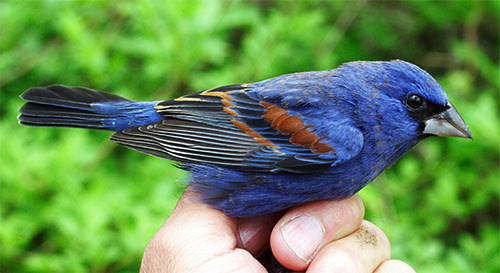

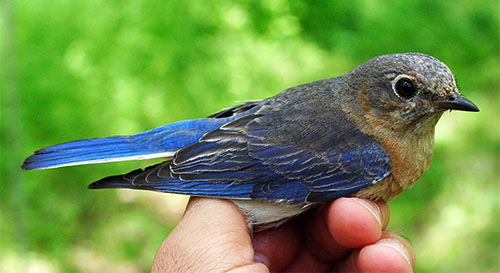
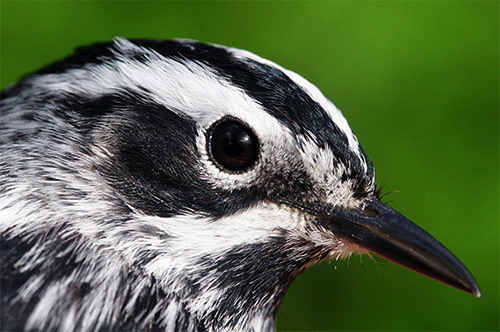
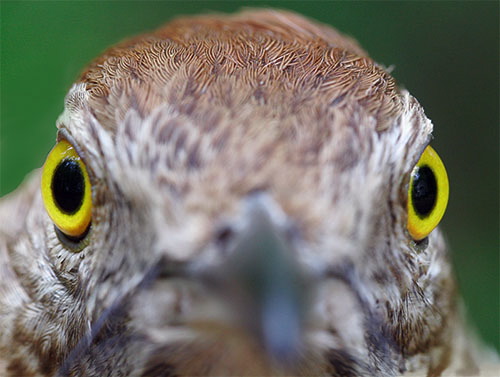
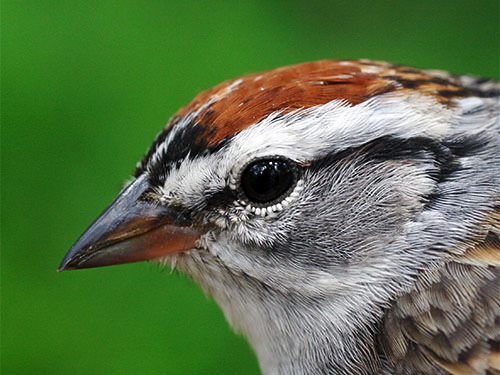
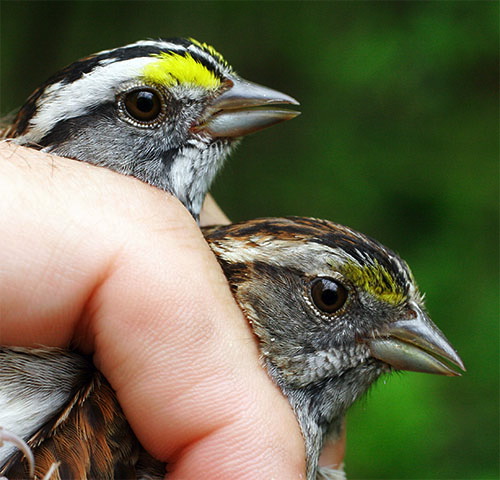
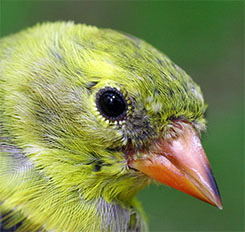 .
.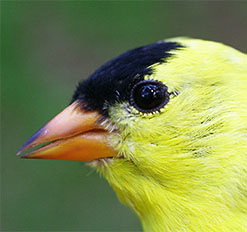
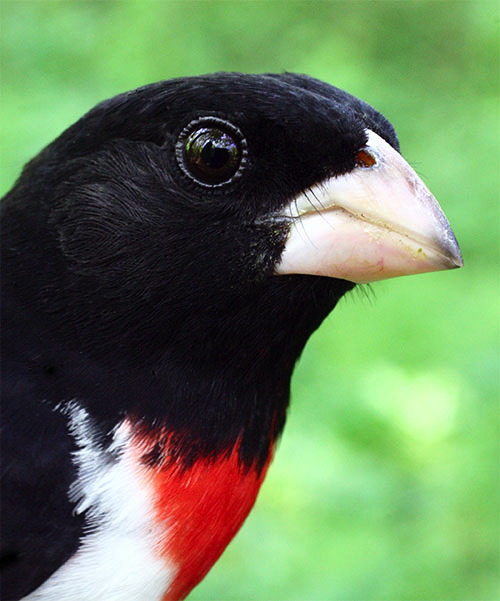

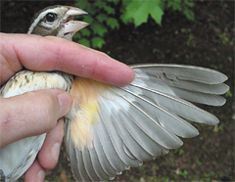 In the male these underwing feathers are rosy like his breast.) The grosbeak's bill is already formidable because of its size, but the lower mandible also has a "tooth" on it that enhances biting power. Sunflowers seeds are no match for this powerful tool; in fact, grosbeaks are even able to open cherry pits. During breeding season they feed their offspring all sorts of wild fruits, along with protein-rich caterpillars and adult insects.
In the male these underwing feathers are rosy like his breast.) The grosbeak's bill is already formidable because of its size, but the lower mandible also has a "tooth" on it that enhances biting power. Sunflowers seeds are no match for this powerful tool; in fact, grosbeaks are even able to open cherry pits. During breeding season they feed their offspring all sorts of wild fruits, along with protein-rich caterpillars and adult insects.

 Please report your
Please report your